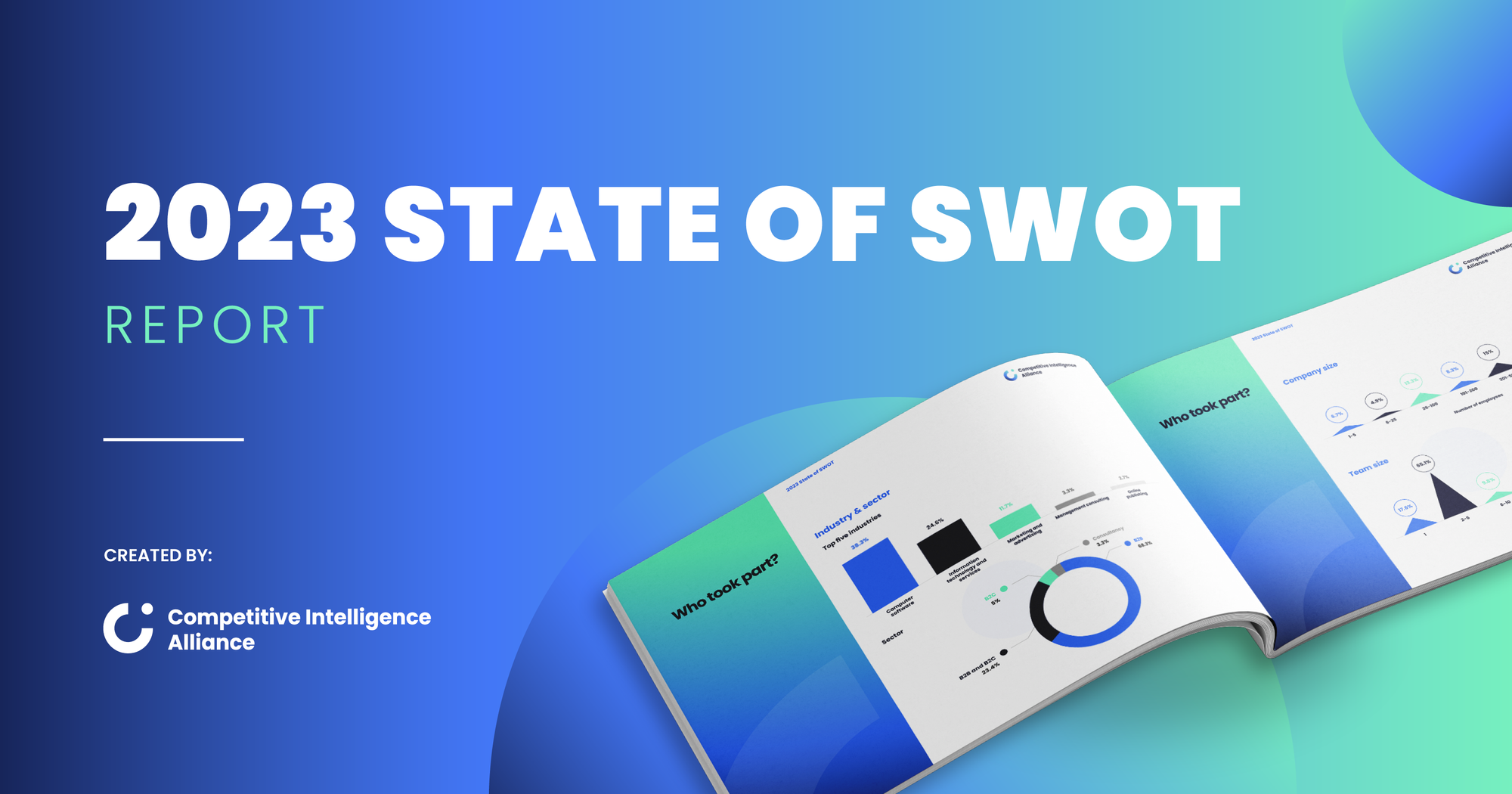SWOT analysis gives you everything you need to build a great battlecard.
Battlecards are all about helping your sales reps position you against competitors. Doing so in a way that closes the deal requires a strong understanding of your competitor’s strengths and weaknesses, as well as your own.
In this article, I’ll walk you through how you can use your findings from SWOT analysis to enable sales and impact revenue by building great battlecards. I’ll even walk you through the format I use for my own battlecards.
Before we get started, if you need to brush up on SWOT analysis itself, what it is, and how to perform it, you can read more at the links below:
Why SWOT analysis is great for building battlecards
SWOT analysis is such a powerful tool because almost everyone already knows what it is, and those that don’t can be brought up to speed in a matter of minutes. Not only does SWOT analysis benefit you by giving you a filter for your data and intel, helping you pull more meaning out of it. It also gives you a framework for sharing that meaning with other folks around the company.
SWOT also gives you a kick-off point for how you’ll handle a competitor. I’ll often turn to one when a new competitor enters the market, because there’s so much you need to learn right away. You take those findings and build them into your messaging and into your battlecards to position yourself in the strongest possible light for customers.
If you’ve ever looked at a battlecard, you know there’s usually a section on your competitor’s strengths (or at least what we consider the competitor’s strengths to be). There’ll be a weaknesses part, too. We call these “kill points”, or “quick dismisses”, but this is intel that comes from the SWOT analysis as well.
All of this informs your strategy around enabling sales to speak about your competitor in a way that maximizes deal-close potential. Perhaps you want to include points on your own strengths in the battlecard, because it’s not intuitively obvious how they counter your competitor’s strengths, or capitalize on their weaknesses. Again, your findings from the SWOT analysis will reveal this.
Pre-SWOT prep work
Before the SWOT analysis itself, there’s some prep work to do.
Most important is to build out a company profile on the competitor you’re dealing with. Include as much detail as you like, but you’ll find this invaluable for building into the SWOT analysis later.
You’ll also save time by educating people on the competitor as you talk to them for your SWOT analysis. If you’re not up-to-speed with a competitor, it’s unlikely many of your colleagues are either. This helps you in your duty to educate others in your org about the competitive landscape and its players.

How to build and format your battlecard step-by-step
Let’s dive into the anatomy of a battlecard. This’ll give you an idea of what the finished product looks like, and a sense of what you’re working towards.
We present our battlecards to sales through our competitive intelligence platform, but these could just as easily sit in a CRM, or even a slide deck.
Here’s the format I like to see:
Let's break these down step-by-step.
1) Competitor overview
First, you want to give your reps a quick overview of the competitor. Some high-level background information on them and what they do that brings people on board with a glance is what you’re aiming for.
The goal for this section is to give the rep just enough information to remind them who the competitor is, or to give them points to bring up in conversation, so they can speak knowledgeably about them.
This should sit right at the top of the page. Always remember that the info you present must be highly useful and relevant for those trying to close a deal right now. There’s no telling what direction a call will go, so your reps will be pulling up battlecards on the fly. If they can’t digest the information on them at a glance, they won’t use them at all. Keep the info concise, and keep it relevant!
2) Quick dismisses
Next up are your “quick dismisses”. This is where you start bringing in competitor weaknesses you uncovered during the SWOT analysis.
The point of the quick dismiss is to draw the prospect’s attention to your competitor’s weaknesses. Especially ones they weren’t aware of. If the prospect brings the competitor up in conversation, or if your rep starts thinking they’re entertaining them as a viable option, the quick dismisses in this section can neutralize that threat without painting your competitor in a negative light.
3) Strengths
As you work down the battlecard, you’ll be offering your rep more information on how you stack up versus your competitor. Hopefully the quick dismiss is all they need, but if not, they can work down each of the following stages as the call goes on.
Here’s where the “battle” in the prospect’s mind is more pronounced. The jump to this section might trigger once the customer starts arguing with your rep about the quick dismisses. They might be making statements like, “But Competitor X has this really great feature, and that’s just what we’re looking for.” Once this happens, it’s clear your prospect thinks of this competitor as a serious option.
That’s why bringing your own strengths to light, and how they compare to your competitors, is a good idea at this stage of the battlecard. (Of course, you’ll have uncovered what you consider your competitor’s strengths to be during your SWOT analysis.)
4) Pricing
Pricing and competitive positioning go hand-in-hand. Having a section on pricing in your battle card will help further support your messaging and how you’re best positioned to fulfill this customer’s specific need, as well as why/how your competitor is not.
Plus, if your competitor is out of budget for your prospect, but they didn’t have detailed quotes on pricing, you can let them know your competitor is out of their price range.
This isn’t necessarily information reps should always use or include, but it’s easy to digest at a glance while they’re on the call, and can be helpful for further framing you as their best option.
5) Landmines
Trap-setting questions are staggeringly effective when used correctly. But they have to be used in the right way, and that can only happen with a strong understanding of your competitor’s weaknesses in relation to your strengths and, most importantly, what the customer wants.
When your rep is good at fishing for information from the prospect about what they’re looking for, they can use your competitor’s (very real) weaknesses to make the prospect second-guess their viability as an option.
Here’s an example. A prospect might call us and let on that they use a bunch of different applications and software products in their tech stack. We might know the competitor they keep mentioning doesn’t integrate well.
That’s a big issue, and a likely deal-breaker for the competitor. When your reps don’t yet know what the customer needs, they can ask how important integration (in this example) is to them.
What makes this so powerful is your rep doesn’t even need to mention the competitor if they know they’re not going to close the prospect then and there. They can educate the customer about how strongly they need integration due to the setup of their current tech stack, and the customer can discover the competitor’s weak integration in their own research. Since the prospect has figured this out “entirely” on their own, it’s incredibly persuasive.
6) Objection handling
SWOT isn’t just useful when performed on competitors. You should also regularly do SWOT analysis on yourself. This will help you anticipate which of your weaknesses prospects are likely to bring up, and why they think Competitor X is a better option.
Such intel is perfect for an objection handling section in your battlecard, which helps sales reps with common, recurring objections. Prepping reps for objection handling has a number of benefits, including shortening the time-to-revenue for many reps (and time-to-first-close for new reps), since they’ll be armed with what they need to close simpler deals from the get-go.
Conclusion
SWOT analysis is the perfect battlecard building tool. What you learn has implications for so many of the very real and practical sections your battlecards need to enable sales reps to close more deals.
When there’s a new competitor on the block, a SWOT analysis will bring you up to speed quickly, give you a recognizable framework for communicating your findings, and help you build an effective battlecard in no time.
Include a quick overview of the competitor at the top of the battlecard, followed by a section on their weaknesses, another on where they’re strong (and how your own strengths compete), plus sections on pricing, trap-setting questions, and objection handling.
SWOT informs all these sections by giving you an understanding of where your competitor is positioned in the market, and where and how to go head-to-head with them to win the deal.
The State of SWOT report
Hungry to learn how pros are using SWOT analysis in 2023?
Our latest report covers everything from:
- The five top challenges you face performing SWOT, and how to solve them.
- The best ways to measure success or failure post-SWOT.
- Whether SWOT is falling out of favor in modern businesses.
- The best alternative frameworks and how they compare with SWOT.
- The future of SWOT analysis.
Ready to learn more? Click the banner below to grab your copy. 👇






.png?v=e4a8f2a0bf)